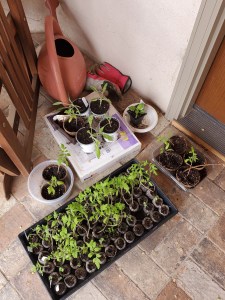Review of Herb Books
Three Herb Books Reviewed
I love cooking with herbs. But I do not own a single culinary herb book. Most of my gardening books have a section on herbs or information on individual herbs. Additionally, I have four herb books mostly based on medicinal uses. They are all quite interesting to read but I have yet to fully utilize their information. I am going to talk about three of the herb books today.
Ortho’s All About Herbs
Maggie Oster is the author of Ortho’s All About Herbs. I own the 1999 edition and find it a compact reference guide. Even though it is condensed, only six pages devoted to culinary use of herbs and a similar number for medicinal use, the guide is chalk full of information. Not much white space is left on the page.
What I like best about this herb book is the table of Common Herbs and Their Uses on pages 8-11. A close second is the detailed index. Since it is a how-to book there are plenty of pages devoted to educating a novice. About half the book is devoted to individual plants. While Basil earns an entire page, most of the described herbs share space. Much like in a garden.
National Geographic Guide to Medicinal Herbs
National Geographic Guide to Medicinal Herbs: The World’s Most Effective Healing Plants was co-authored by Rebecca L. Johnson, Steven Foster, Tieraona Low Dog, M.D. and David Kiefer, M.D. This book is impressive. Gorgeous photography and beautiful illustrations accompany eight chapters of herbal information.
Since this herb book focuses on medicinal use, the plants are grouped by which part of the body they aid. For example, Chapter Four covers herbs useful for digestive ailments. However, each herb is only covered under one section. But the authors do indicate alternative therapeutic uses.
Readers may find it interesting to discover the inclusion of plants not considered herbs. Perhaps the inclusion of edibles such as tomatoes and various berries is the reasoning behind the long title. Whether herb or non-herb, the information contained is extensive.
Medicinal Plants At Home
The third book I want to share comes to us via Spain. Marìa Trànsito Lòpez Luengo and Carlota Màñez Arisò are the co-authors of the informative herb book Medicinal Plants at Home. I like how the authors organized the book.
First, there is an overall introduction. Then, the herbs are broken into groupings for subgroups of individuals, travelers, children, the elderly, etc. There is a short section on using herbs throughout the house and then the herbs are typed by how they affect the body. The authors discuss if the herbs are used for relaxation, anti-inflammatory purposes or as an immuno-stimulant.
Each herb is discussed and photographed. The authors indicate uses and include precautions and if/when the herb is contraindicated. Further, the plant is described and natural habitat disclosed. A recipe for each is included under the remedies section.
Herb Books for the Herb Garden
I am still expanding my herb garden. Currently, my herbs have more culinary applications than medicinal. While I have added both rose hips and lavender to my bath water, I have yet to make any teas or poultices. My horehound is a wonderful ground cover but I do not know how to turn it into a cough drop.
A fourth herb book is quite different and I am still reading it. Therefore The Illustrated Encyclopedia of Healing Remedies will be reviewed at a later date.
Modern medicine has replaced herbal medicine at the household level. I truly do not personally know anyone who mixes their own concoctions. My comfort level at this point in time is quite low with respect to preparing my own medicinal therapies. But, I am interested in adding herbal teas to my repertoire.
Enjoy the slide show.




































 The year 2020 brings forth an unusual Easter. Here in the United States many locations have enacted a
The year 2020 brings forth an unusual Easter. Here in the United States many locations have enacted a 


 Hide Away by
Hide Away by  March 2020 has been a long month. Covid-19 is a pandemic and has caused widespread damage. Both lives and economies will be impacted in the near future. I cannot foresee the long term consequences, but there will naturally be repercussions. So, I spend a small amount of time daily looking to the future.
March 2020 has been a long month. Covid-19 is a pandemic and has caused widespread damage. Both lives and economies will be impacted in the near future. I cannot foresee the long term consequences, but there will naturally be repercussions. So, I spend a small amount of time daily looking to the future.





















